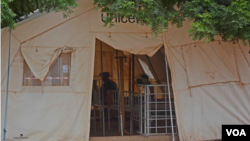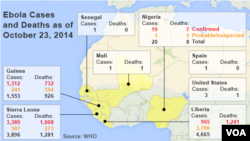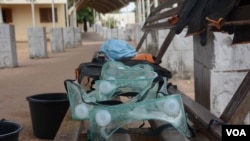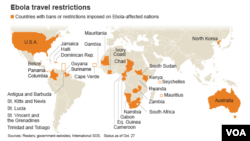In Kayes, medical staff and national health officials are working to trace, monitor and get health facilities up and running after Mali reported its first case of Ebola last week. Dozens of people are in isolation at the regional hospital where the 2-year-old girl was treated before dying of the virus. More cases are expected in the coming days.
At around 10 a.m. on October 22, Abdouramane Koungoulba, the pediatrician at the Fousseyni Dao hospital in Kayes, western Mali, received the young patient who had been brought in by a relative. The toddler had a high fever and a nosebleed.
The girl was born and was being raised in Kayes, he was told. Not until later did he learn she had recently come from Guinea, where she lived with her father before he died. Nor was he told that the baby and her grandmother had made the long journey from Guinea to Kayes, via the Malian capital, Bamako, on public buses.
According to the relative, the proper medical response was delayed by several hours because they did not have this vital information.
A day later, Mali became the sixth West African country to report a case of Ebola.
Some 5,000 people have died since the first case appeared in Guinea in December. Most are in that country, Liberia and Sierra Leone. Nigeria and Senegal had reported cases, but the World Health Organization praised their quick action in tracking the virus and potential contacts. Neither country has reported an active case in weeks.
Malian health authorities issued an announcement on a national broadcast by the evening of October 23. The hunt was then on for anyone who had been in direct contact with the girl and her grandmother as they travelled over 1,000 kilometers from Guinea to Bamako.
Authorities moved swiftly. A car was dispatched to catch the bus that had carried the toddler and her grandmother.
In Kayes, some 60 people who had first or second-hand contact with the girl are currently isolated and are being monitored at the hospital or in their homes by local health teams for signs of the hemorrhagic fever.
“They come and take our temperature two times a day”, explains Maimouna Konate.
She did not dare to give her real name out of fear for the stigma the community might impose on her.
Fear, suspicion
In Kayes, fear and suspicion has gripped residents. Some people wear masks, while others use protective gloves. Almost everyone avoids handshakes when greeting friends and family, instead bumping elbows or moving the hand toward the heart.
In the days after the Ebola case was confirmed, health care workers complained about not having received proper training.
"It’s true some of the staff were concerned and even threatened to stop working. The problem was solved when religious leaders and health officials from Bamako were called in to mediate," says Dr. Koumare Toumani, the Kayes hospital's director-general.
“It’s worrying especially since the little girl was showing symptoms as she was travelling by bus,” adds Dr. Samba Sow from the National Center for Disease Control, CNAM, in Bamako.
Sow arrived in Kayes Friday to lead the region's Ebola response efforts. Over the weekend, health workers and volunteers were trained to trace anyone who had been in contact with the girl.
“If you have one case very early on and you catch it, you’re actually lucky,” says Sow. “If you don’t detect that first case you run the risk of people who are contagious staying in the community without being reported and that’s when you run the risk of an epidemic."
Social sensitization in schools began Monday. By Tuesday, a center for diagnostics and observation built by UNICEF was in place at the Kayes hospital. Screenings at the border with Senegal will be reinforced over the next days.
“It’s true we were taken by surprise by having a case here in Kayes. The structures to trace and monitor Ebola cases were not yet in place. Now, with the help from NGOs coming from Bamako, we are setting up the infrastructure to receive and isolate more patients,” says Dr. Koumare Toumani.
In the Kayes hospital’s paediatrics’ department, Koungoulba ponders whether he fully protected himself while treating the girl.
"Did I really follow all the safety precautions treating the litte girl? Did I touch her soiled diaper or the blood running from her nose? These are questions I ask myself over and over again," he said.
Diplomats and international health officials fear more cases will be registered in the coming days.













